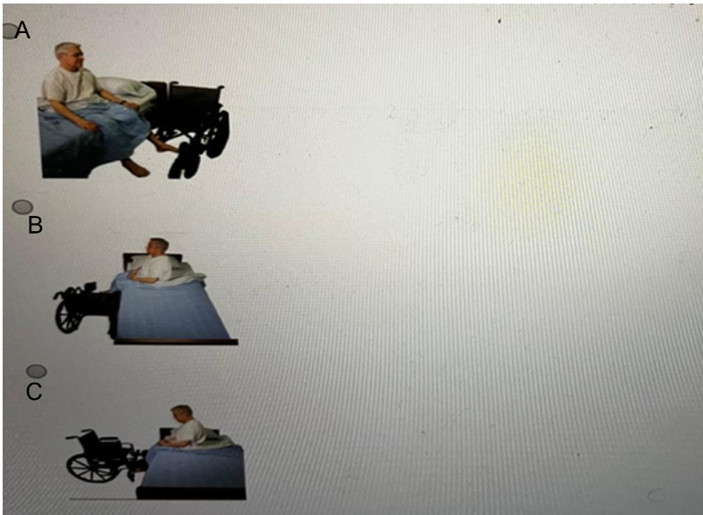A nurse is preparing to assist a client out of bed to a wheelchair following left knee surgery. The nurse should identify that which of the following images indicates the correct placement of the wheelchair?

A
B
B
The Correct Answer is C
A. Wheelchair is on the left side, which is the postoperative knee, risking strain or injury to the healing limb during transfer. Not ideal for maximizing client safety and independence in mobility.
B: Wheelchair is placed at the head of the bed, making it impractical and unsafe for transfer. No clear pivot point, and body mechanics would be compromised for both the nurse and the client.
C. The wheelchair is positioned on the client's right side, which is the unaffected leg, allowing the client to pivot and transfer using their stronger limb. This placement minimizes strain on the left surgical knee, which reduces pain and risk of injury.
Nursing Test Bank
Naxlex Comprehensive Predictor Exams
Related Questions
Correct Answer is A
Explanation
A. Leave the needle in place for 10 seconds after the injection: Leaving the needle in place for approximately 10 seconds after administering a subcutaneous injection helps ensure full delivery of the medication and reduces the chance of medication leakage at the injection site.
B. Use a 5-inch needle for the injection: A 5-inch needle is excessively long for subcutaneous injections and would likely penetrate muscle tissue, increasing the risk of injury or incorrect medication administration. Subcutaneous injections typically require a needle length between ⅜ and ⅝ inch.
C. Inject the medication using the Z-track technique: The Z-track technique is used for intramuscular injections to minimize medication leakage and reduce irritation. It is not appropriate for subcutaneous injections, which are administered into the fatty layer beneath the skin, not deep muscle tissue.
D. Insert the syringe at a 15° angle during injection: A 15° angle is used for intradermal injections. Subcutaneous injections should be administered at a 45° to 90° angle depending on the client’s body mass to ensure the medication is delivered into the subcutaneous tissue, not the dermis or muscle.
Correct Answer is D
Explanation
A. Check the client's medical records to see which medications were recently administered:
While reviewing medications is important for understanding potential causes of hypoxia, it is not the immediate priority when a client’s oxygen saturation is low. Immediate assessment and intervention to improve oxygenation come first.
B. Notify the charge nurse of the client's condition: Notifying the charge nurse is important but should follow an initial assessment and attempt to address the problem. Immediate client reassessment takes precedence to determine the current status and possible interventions.
C. Review the client's most recent SaO2 level in the medical record: Checking prior oxygen saturation levels can provide context but does not directly address the acute finding of 88% saturation, which requires prompt evaluation and action.
D. Recheck the client's SaO2 level after having the client cough and clear their throat: This action directly addresses a common cause of transient hypoxia such as airway obstruction from secretions. Reassessment after clearing the airway is the priority to determine if oxygenation improves before escalating interventions.
Whether you are a student looking to ace your exams or a practicing nurse seeking to enhance your expertise , our nursing education contents will empower you with the confidence and competence to make a difference in the lives of patients and become a respected leader in the healthcare field.
Visit Naxlex, invest in your future and unlock endless possibilities with our unparalleled nursing education contents today
Report Wrong Answer on the Current Question
Do you disagree with the answer? If yes, what is your expected answer? Explain.
Kindly be descriptive with the issue you are facing.
